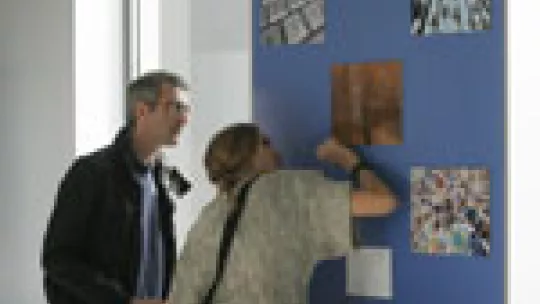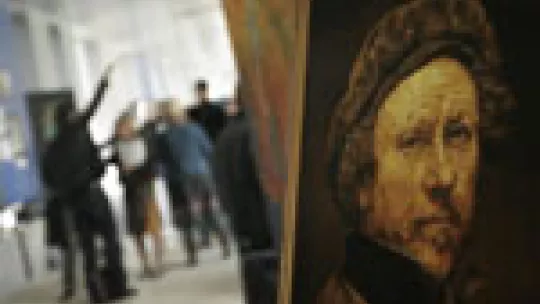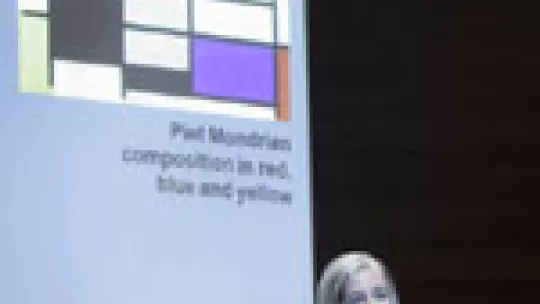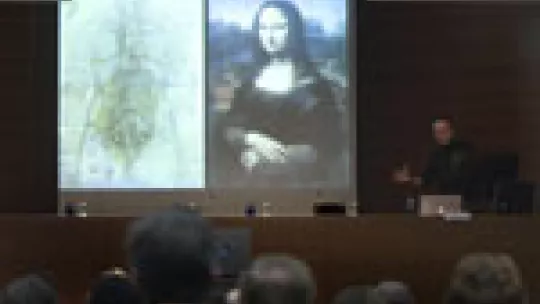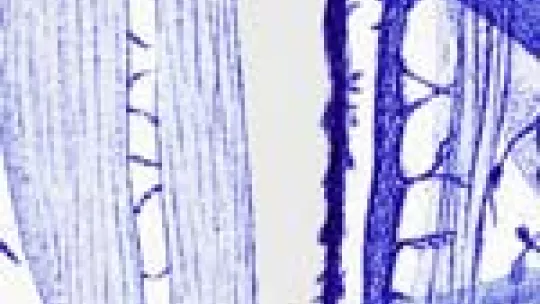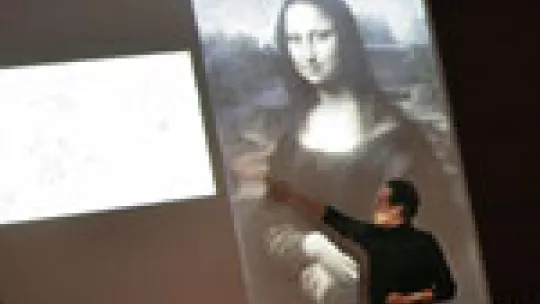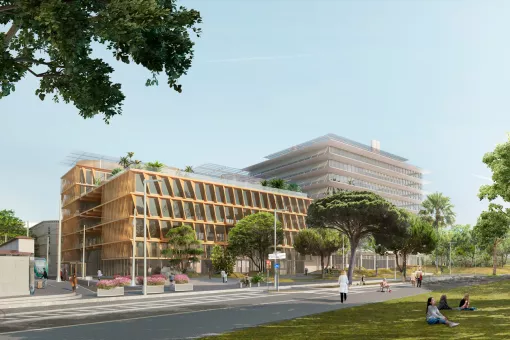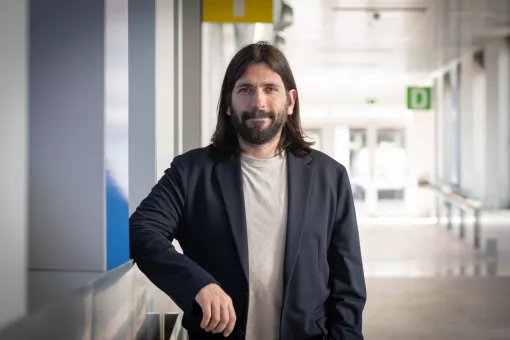Images
A select group of prestigious theorists, scientists and artists are to participate in the “Creativity, Science and Art” Forum, which will be held on Wednesday 11 November at the Barcelona Science Park.
What is science and what is art? How do they come together in nature? What are the features common to them and what are those that differentiate them? In what way do creativity and intuition contribute to science and art? To what extent are the concepts of knowledge, beauty and enigma associated with science and art? The Institute for Research in Biomedicine (IRB Barcelona) has invited a select group of international scientists, artists and theorists to talk about the Art-Science symbiosis in the Barcelona BioMed Forum entitled “Creativity, Science and Art”. The forum will be held from 10h to 14h on Wednesday 11 November in the Antoni Caparrós Auditorium at the Barcelona Science Park, home to IRB Barcelona. The sessions (which will be in English) and the activities programmed are free of charge and open to the general public and the scientific and artistic communities of the city.
The Forum’s programme includes a plenary lecture, from 10h to 11h, by Martin Kemp, Emeritus Professor of the History of Art at Trinity College, Oxford University. Kemp is an international authority on the work of Leonardo da Vinci, the Italian humanist of the Renaissance period who combined science and art in an extraordinary way. Kemp’s extensive research trajectory includes the sciences of optics, anatomy and natural history in key moments of the history of naturalism. Last October, Kemp hit the headlines for his contribution to discovering that a portrait of a young Italian lady made on parchment had been done by Leonardo. Valued at 12,000 € in an auction held in New York in 1998, this drawing could now be worth more than 150 million €.
The plenary session will be followed by a debate, from 11h to 12h, between the Portuguese bioartist Marta de Menezes and the IRB Barcelona scientist Marco Milán, head of the Developmental Biology Programme. Both work with cell manipulation but with distinct goals: the artist to create new forms of natural art using scientific techniques and methods and the scientist to study the wing development of the fruit fly Drosophila melanogaster and to elucidate the basic cell processes that are of biomedical relevance. The debate will touch on the limits of science and art in the manipulation of nature, in addition to other topics. Josep Perelló, Aggregate Professor of Fundamental Physics at the University of Barcelona and director of the Science Division of the centre “Arts Santa Mònica”, will chair the debate.
The last session, from 13h to 14h, will bring together Jorge Wagensberg, Professor of Physics at the University of Barcelona, and Jordi Cervelló, Catalan violinist and composer. They will talk about their experience in composing a symphony based on the principles of physics. This will be a stimulating talk on how musical and scientific language converge in the shape of things in the world around us.
There will also be an exhibition of exceptional artwork during the Forum. This will include a selection of fifteen drawings and images from “Paisajes Neuronales”, which comprise work by the neuroscientist Ramon y Cajal and have been loaned to IRB Barcelona by “la Caixa” Foundation (Obra Social). The fifteen reproductions will be accompanied by artwork by members of the scientific community at IRB Barcelona, in addition to contributions by local artists.
An “Artists in Residence” programme has been organised on the day before the Forum (Tuesday 10 November). Three artists will be working for a day in IRB Barcelona labs to get first hand experience of some of the techniques used in current biomedical research. The aim of this activity is to provide the artists with scientific tools in order to inspire future projects. The Portuguese artist Marta de Menezes, and the Catalan artists Joan Cruspinera and Mireya Masó have been selected to participate in this initiative. All three explore nature from an artistic perspective.
The Forums at IRB Barcelona
“Creativity, Science and Art” is the third in a series of forums organised by IRB Barcelona. The Barcelona BioMed Forums host members of our scientific community, scholars from other disciplines as well as members of the public in order to engage them in multidisciplinary debate about issues related to biomedical science with the ultimate goal of bringing science and society closer together. The Barcelona BioMed Forums are events open to the public at large.
Brief information about the participants
Martin Kemp
Martin Kemp has written extensively on Imagery in Art and Science from the Renaissance period until the modern day. His activity centres on Leonardo da Vinci, the subject of several books written by him and exhibitions that he has organised. His interests include the sciences of optics, anatomy and the natural history of key periods in the history of naturalism. In 1989 he published The Science of Art. Optical Themes in Western Art from Brunelleschi to Seurat (Yale University Press). Kemp’s most recent work is devoted to the "New History of the Visual," which addresses a huge number of objects from science, technology, the fine arts, and applied and traditional arts devised to create models of nature and to enhance human relations with the physical world. He occasionally writes a column entitled 'Science in Culture' in the scientific journal Nature.
Kemp studies Natural Sciences and the History of Art at Cambridge University and at the Courtauld Institute in London. He worked in Scotland for more than 25 years (University of Glasgow and University of St. Andrews, where he was the Provost of St. Leonard's College). He has held visiting posts in Princeton, New York, North Carolina and Los Angeles. Among other responsibilities, he has served on the Board of Trustees of the National Galleries of Scotland, the Victoria & Albert Museum and the British Museum.
Marta de Menezes
Marta de Menezes is a Portuguese artist (Lisbon, 1975) who holds a Degree in Fine Arts from the University of Lisbon and a Masters in the History of Art and Visual Culture from the University of Oxford. In recent years she has explored the interactions between Art and Biology, working in research labs to show that new biological technologies can useful means to create new forms of art and that labs can also serve as art studios. In addition to studying new forms of artistic expression, Marta de Menezes is also an expert in traditional media, with paintings that often illustrate observations made during scientific research. She is currently working at the MRC - Clinical Sciences Centre, Imperial College of Science, Technology and Medicine, in London.
Jorge Wagensberg
Jorge Wagensberg is a professor of the Theory of Irreversible Processes at the Faculty of Physics at the University of Barcelona and scientific director of the “Fundació la Caixa”. As an editor, conference speaker, writer, and specialist in museum studies, Wagensberg is one of the most prominent figures in the dissemination of science in Spain. Between 1991 and 2005, he was responsible for setting up and directing the science museum of the “Fundació la Caixa” in Barcelona, and he also oversaw the renovation that culminated in the CosmoCaixa, a reference for science museums throughout the world. He has written for newspapers, and has produced more than 20 books and 100 articles on thermodynamics, mathematics, biophysics, microbiology, palaeontology, entomology, scientific museum studies and the philosophy of science. He holds the 2005 National Prize of Catalonia for Scientific Thought and Culture (Premi Nacional de Catalunya al Pensament i la Cultura Científica) and the 2007 Saint George’s Cross (Creu de Sant Jordi), awarded by the Generalitat de Catalunya (Government of Catalonia).
Jordi Cervelló
Jordi Cervelló was born in Barcelona in 1935. He began violin classes at the age of six with the violinist Rosa García and then with Joan Massiá. Later, he studied virtuosity with Eugen Prokop and Franco Tufari. From 1960 onwards he turned to composition under the instruction of Josep M. Roma, with whom he had studied harmony, counterpoint and instrumentation.
Cervelló’s prizes include the City Award of Barcelona in 1973 (Ciutat de Barcelona) for the symphonic composition “Seqüències sobre una mort” and in 1976 the first prize in the Permanent Competition of the Ministry of Education and Science for the piece “Biogénesis”. His music is known throughout Europe, the United States and Israel. Some of his pieces for a string orchestra, such as “Dos moviments”, “Anna Frank”, “un symbol”, “Concerto grosso” and “Cimento di luce e tenebra”,have been interpreted by The English Chamber Orchestra, the Moscow Virtuosi Chamber Orchestra, the Netherlands Chamber Orchestra and the “Camerata Lysy Gstaad”.
Topic: CREATIVITY, SCIENCE AND ART
Date: Wednesday 11 November 2009
Time: 10h - 14h
Venue: Antoni Caparrós Auditorium. TOWER D, Parc Científic de Barcelona
C/ Baldiri Reixac, 4. 08028 Barcelona
Organised by: Institute for Research in Biomedicine (IRB Barcelona)
About IRB Barcelona
The Institute for Research in Biomedicine (IRB Barcelona) pursues a society free of disease. To this end, it conducts multidisciplinary research of excellence to cure cancer and other diseases linked to ageing. It establishes technology transfer agreements with the pharmaceutical industry and major hospitals to bring research results closer to society, and organises a range of science outreach activities to engage the public in an open dialogue. IRB Barcelona is an international centre that hosts 400 researchers and more than 30 nationalities. Recognised as a Severo Ochoa Centre of Excellence since 2011, IRB Barcelona is a CERCA centre and member of the Barcelona Institute of Science and Technology (BIST).

